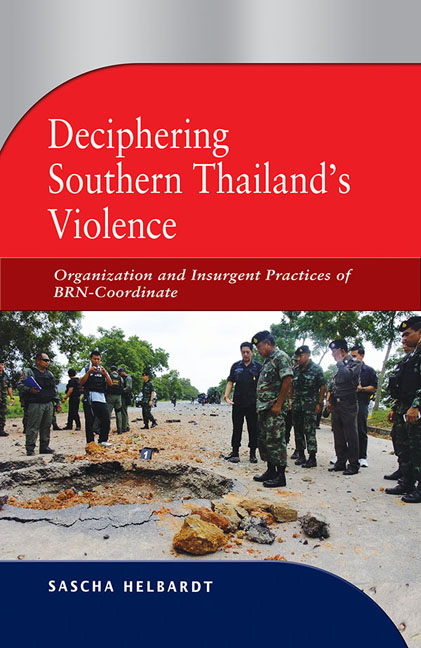Book contents
- Frontmatter
- Dedication
- Contents
- List of Figures
- List of Abbreviations
- Preface and Acknowledgments
- 1 Introduction
- 2 Organizational Aspects of BRN-Coordinate
- 3 Making Insurgents: Recruitment, Training and Control
- 4 Bringing the Actors Back In: Who Are the Insurgents?
- 5 Making Sense of Violence: Power and the Insurgency's Communicative Side
- 6 Conclusion
- References
- Bibliography
- About the Author
5 - Making Sense of Violence: Power and the Insurgency's Communicative Side
Published online by Cambridge University Press: 19 May 2017
- Frontmatter
- Dedication
- Contents
- List of Figures
- List of Abbreviations
- Preface and Acknowledgments
- 1 Introduction
- 2 Organizational Aspects of BRN-Coordinate
- 3 Making Insurgents: Recruitment, Training and Control
- 4 Bringing the Actors Back In: Who Are the Insurgents?
- 5 Making Sense of Violence: Power and the Insurgency's Communicative Side
- 6 Conclusion
- References
- Bibliography
- About the Author
Summary
One of the most intriguing features of Southern Thailand's insurgency is the fact that rebels avoid taking credit for their violent deeds, leaving some observers to speak of a “conspiracy of silence”. In contrast to the practice of Basque or Northern Ireland's separatists, no warnings are provided before an attack, no identifiable demands are made in connection to the violence, and no group takes responsibility. Analysing such claims of responsibility is important because it grants access to what perpetrators demand and, partly, to what logic drives their violent behaviour. If armed groups refrain from taking responsibility, it is typically interpreted as a sign of pathological inversion or a fragmentation of armed actors who apparently have no clear political agenda. These groups are seemingly not interested in political mobilization and commit acts of violence only as a purely self-referential act.
This chapter argues that although BRN-Coordinate and other insurgent groups publicly avoid taking credit for their actions, violence in the three provinces can be understood as a highly communicative act if scholars move beyond the victim-perpetrator interaction to the wider symbolic function that violence has for different local audiences. Here, violence itself becomes a symbol and this facilitates its integration into social structures. The communication of organized forms of violence, such as civil wars, terrorism or insurgency, is closely connected to different collectives. Collectives serve as the organizers of violence, providing, for example, channels of communication, legitimacy, support for fighters, while it also integrates violence into the collective. Conversely, violence can also demarcate the borders of collectives.
These collectives do not necessarily correspond with ethnic borders, surely as not all Malays support the insurgency. Askew (2009, pp. 71– 76), for example, describes accounts of insurgency by non-supporters. If, however, the insurgency had no supporters beyond the insurgents themselves, it would be just a non-enduring, peripheral phenomenon in society. Accordingly, the aim of this chapter is not to evaluate the overall strength of support, but rather to identify popular accounts of Malay supporters and to explain how local acceptance of insurgent violence is connected to the stigmatization of Malay Muslims in the Thai nation state, as well as to the specific forms of insurgent violence. It will show that BRN-Coordinate employs demonstrative violence as a strategic tool, while identifying how the group attempts to actively manipulate the Malay population's reception of state as well as rebel violence.
- Type
- Chapter
- Information
- Deciphering Southern Thailand's ViolenceOrganization and Insurgent Practices of BRN-Coordinate, pp. 180 - 231Publisher: ISEAS–Yusof Ishak InstitutePrint publication year: 2014



